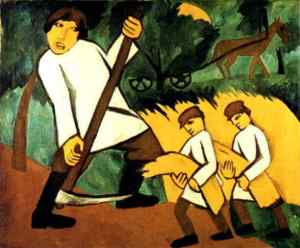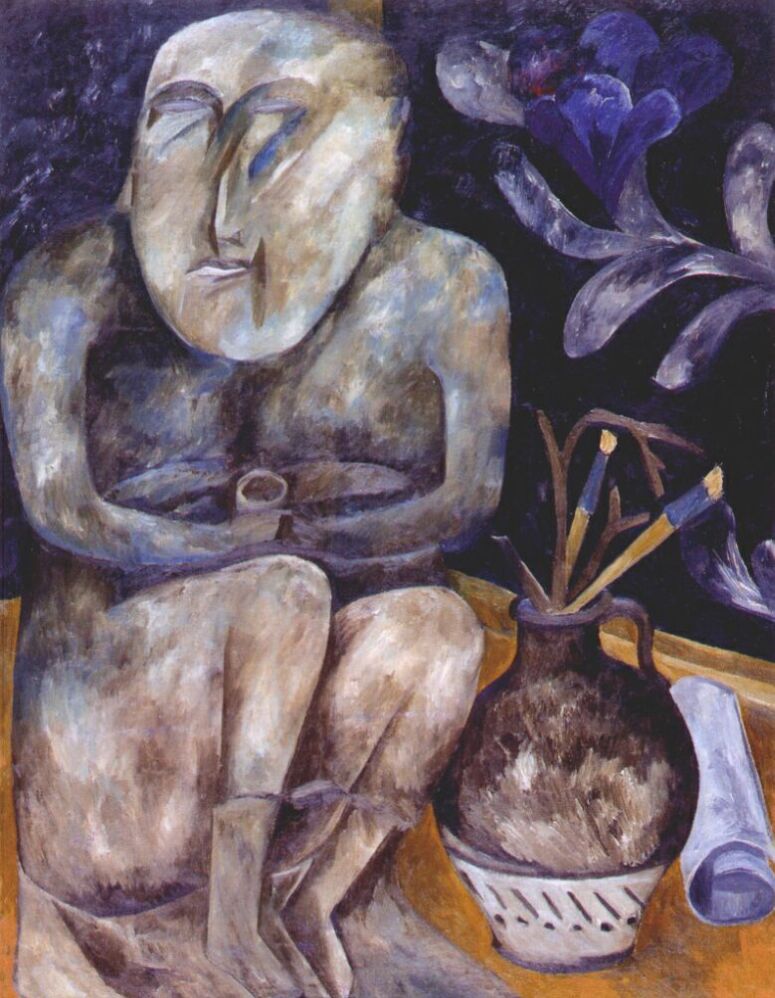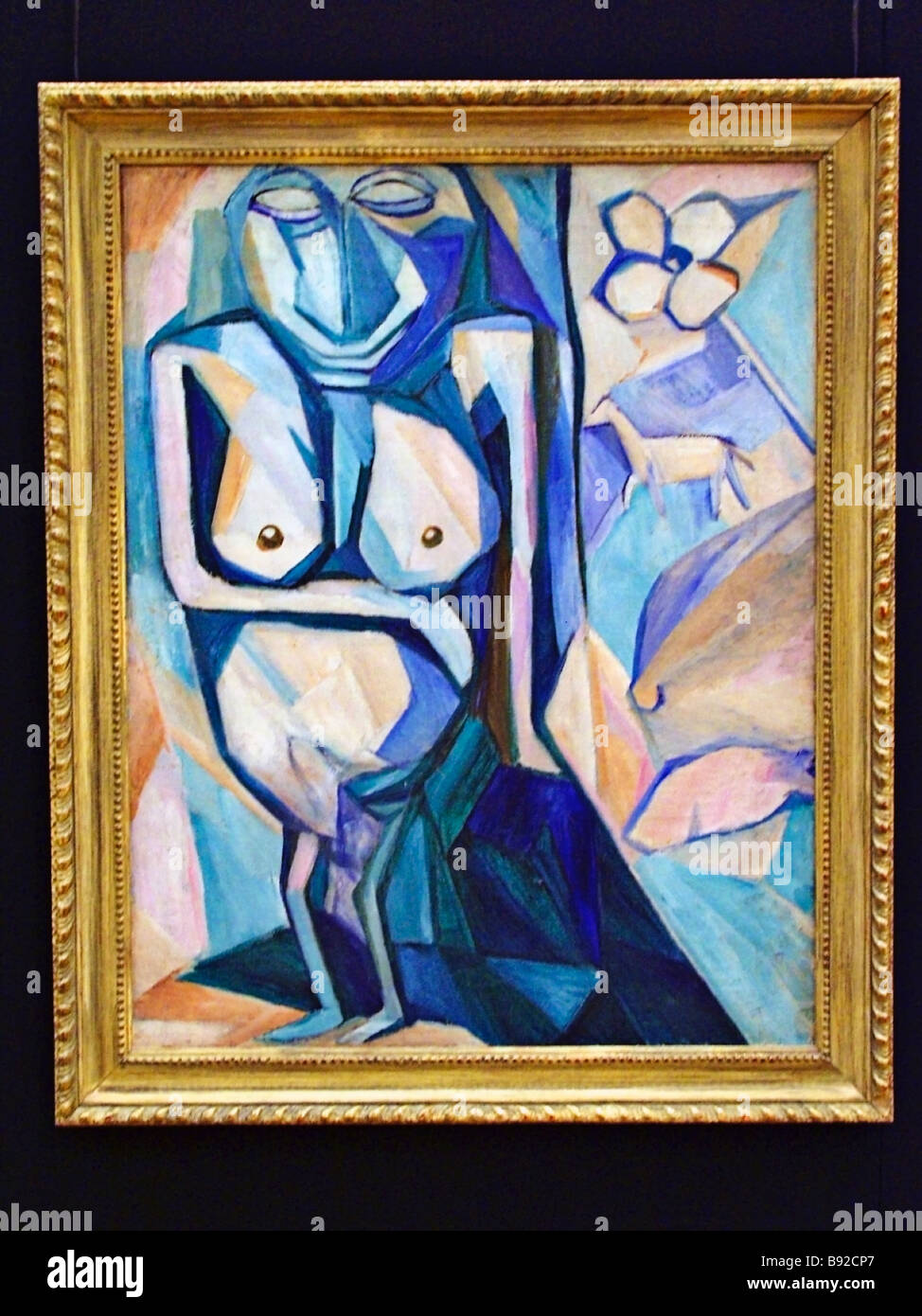I discovered the artist Natalia Goncharova while looking at Futurism on the Art Foundation course last year. I liked the fact that through her well-known painting The Cyclist with its Futurist devices of depicting time and speed with multiple outlines, she challenged the Italian Futurists obsession with machines by choosing a more peaceful mode of transport, a bicycle. The cyclist is also willfully heading in the opposite direction to that indicated by the pointing authoritarian finger, but then Goncharova was definitely not afraid of challenging convention throughout her life.
 |
| The Cyclist (1912-13) |
As I'm currently working on some pieces influenced by Mithila painting (traditional folk art of Nepal), and want to express a connection to my own agriculturist ancestors, I re-visited Goncharova's paintings from her Neo-Primitivism stage that were influenced by Russian peasant culture and country life.
Already for several years before 1912, she and her partner Mikhail Larionov were intrigued with folk art, children’s paintings and self-taught artists, such as Georgian Niko Piromanishvili.
At the start of the twentieth century, Russia was primarily
a peasant country steeped in folk aesthetics such as icons, embroidered towels, home-made mats and rugs, wooden houses with carved window casings, jambs and lintels, painted clay toys - all made by the hands of friends and relatives - and not considered works of art. Goncharova was one of the first Russian artists to perceive and value the high artistic merits of Russian national creativity.
The hard edges, strong images, colours, lines, flatness and naively depicted characters are typical of indigenous folk painting. However, although on the surface, these paintings are bold and deceptively simple, on closer inspection they brim with subtleties and emotional potency. As explained by Goncharova, the need to go back to these naive forms of art, are necessary to find new forms.
Folk art is not refined. But it is direct and sincere, taken from its direct surroundings revealing the instinct of the tribe/community, the people unconsciously preserving the treasure of these primal concerns.
 |
| 1910, ʻHay Cuttingʼ has elements of Cubism and Gauguin |
 |
Gardening
1908
Oil paint on canvas
|
 |
| Allotment, 2014 |
 | ||
Unlike Gauguin's weightless native people, who do not so much stand on the soil as appear "suspended" between beams of golden light, Goncharova's peasant women have their feet more firmly planted on the ground.
Goncharova was fascinated by the 6-8 feet high rough hewn
stone statues of male and female figures known as kamennaia baba, that are scattered over the
southern steppes of Russia, frequently found atop burial mounds and believed to represent the ancestors of those who originally erected them:
non-Slavic tribes, among them the Scythians who occupied these areas as far
back as the iron and bronze age. Growing up on her grandmother's country estate, Goncharova would have heard popular legends that tell of the rootedness of the Russian people in nature.
 |
| Stone maiden (Still life) |
 |
| Pillars of Salt (1908) |
Goncharova's paintings were not just beautiful in themselves. They made socio-political statements, were full of symbolism such as woodcutters cutting away the old to make way for the new reflecting the 1905 and 1917 Russian revolutions. She choses ubiquitous figures at work and makes them her own by incorporating elements of styles such as cubism and fauvism.
Relating this to my own work has given me new insight and ideas. For example, I might chose to depict people living alternative lifestyles such as those I have stayed with in Tinker's Bubble and Tipi Valley as a statement about manmade environmental destruction of the planet. I might depict these 'basic' ways of living - in yurts, not using machines - as an anti-capitalist statement. I might depict women talking in groups sitting on the earth with their children as a way of showing that motherhood is still undervalued in society, or groups of all ages of people sitting together in front of a fire on the street (as in Nepal) to show how capitalism has alienated us from each other in the West.
Another concern is where to locate my source for the primitive in my art. Do I stay close to my ancestors like Russian artists and writers, (south-west England and Wales)? Or do I turn, like Picasso to Africa, or Maia Deren to Haiti (perhaps important soul places rather than being actually ancestrally linked). In which case, looking to Nepal and India seems valid for me also. Perhaps there are more similarities than one might think anyway - as theories such as Jung's collective unconscious imply.




No comments:
Post a Comment